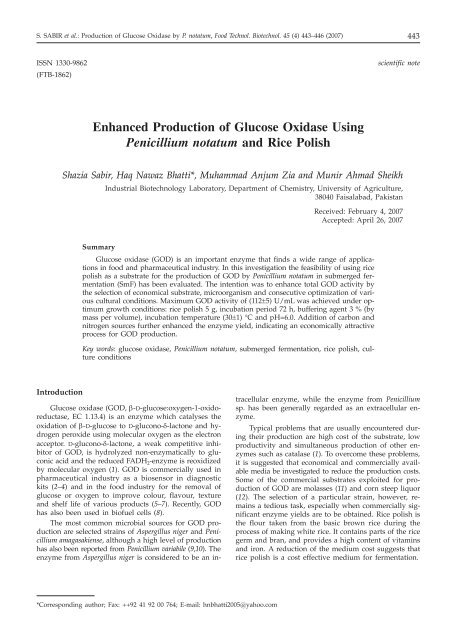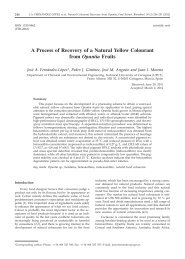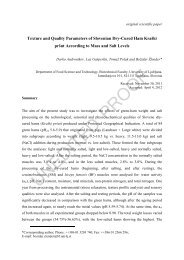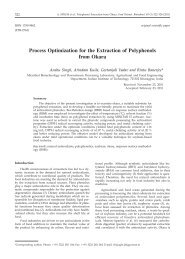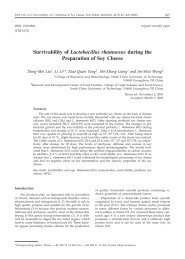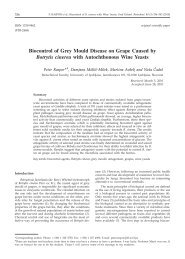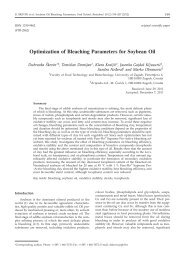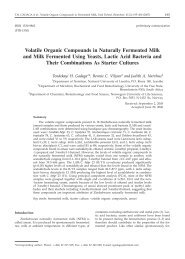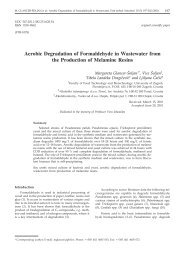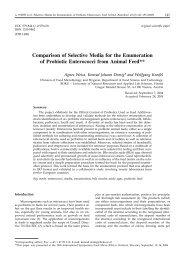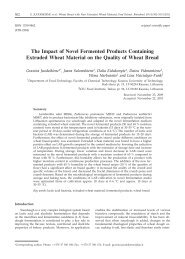Enhanced Production of Glucose Oxidase Using Penicillium ...
Enhanced Production of Glucose Oxidase Using Penicillium ...
Enhanced Production of Glucose Oxidase Using Penicillium ...
- No tags were found...
You also want an ePaper? Increase the reach of your titles
YUMPU automatically turns print PDFs into web optimized ePapers that Google loves.
S. SABIR et al.: <strong>Production</strong> <strong>of</strong> <strong>Glucose</strong> <strong>Oxidase</strong> by P. notatum, Food Technol. Biotechnol. 45 (4) 443–446 (2007)443ISSN 1330-9862(FTB-1862)scientific note<strong>Enhanced</strong> <strong>Production</strong> <strong>of</strong> <strong>Glucose</strong> <strong>Oxidase</strong> <strong>Using</strong><strong>Penicillium</strong> notatum and Rice PolishShazia Sabir, Haq Nawaz Bhatti*, Muhammad Anjum Zia and Munir Ahmad SheikhIndustrial Biotechnology Laboratory, Department <strong>of</strong> Chemistry, University <strong>of</strong> Agriculture,38040 Faisalabad, PakistanReceived: February 4, 2007Accepted: April 26, 2007Summary<strong>Glucose</strong> oxidase (GOD) is an important enzyme that finds a wide range <strong>of</strong> applicationsin food and pharmaceutical industry. In this investigation the feasibility <strong>of</strong> using ricepolish as a substrate for the production <strong>of</strong> GOD by <strong>Penicillium</strong> notatum in submerged fermentation(SmF) has been evaluated. The intention was to enhance total GOD activity bythe selection <strong>of</strong> economical substrate, microorganism and consecutive optimization <strong>of</strong> variouscultural conditions. Maximum GOD activity <strong>of</strong> (112±5) U/mL was achieved under optimumgrowth conditions: rice polish 5 g, incubation period 72 h, buffering agent 3 % (bymass per volume), incubation temperature (30±1) °C and pH=6.0. Addition <strong>of</strong> carbon andnitrogen sources further enhanced the enzyme yield, indicating an economically attractiveprocess for GOD production.Key words: glucose oxidase, <strong>Penicillium</strong> notatum, submerged fermentation, rice polish, cultureconditionsIntroduction<strong>Glucose</strong> oxidase (GOD, b-D-glucose:oxygen-1-oxidoreductase,EC 1.13.4) is an enzyme which catalyses theoxidation <strong>of</strong> b-D-glucose to D-glucono-d-lactone and hydrogenperoxide using molecular oxygen as the electronacceptor. D-glucono-d-lactone, a weak competitive inhibitor<strong>of</strong> GOD, is hydrolyzed non-enzymatically to gluconicacid and the reduced FADH 2 -enzyme is reoxidizedby molecular oxygen (1). GOD is commercially used inpharmaceutical industry as a biosensor in diagnostickits (2–4) and in the food industry for the removal <strong>of</strong>glucose or oxygen to improve colour, flavour, textureand shelf life <strong>of</strong> various products (5–7). Recently, GODhas also been used in bi<strong>of</strong>uel cells (8).The most common microbial sources for GOD productionare selected strains <strong>of</strong> Aspergillus niger and <strong>Penicillium</strong>amagasakiense, although a high level <strong>of</strong> productionhas also been reported from <strong>Penicillium</strong> variabile (9,10). Theenzyme from Aspergillus niger is considered to be an intracellularenzyme, while the enzyme from <strong>Penicillium</strong>sp. has been generally regarded as an extracellular enzyme.Typical problems that are usually encountered duringtheir production are high cost <strong>of</strong> the substrate, lowproductivity and simultaneous production <strong>of</strong> other enzymessuch as catalase (1). To overcome these problems,it is suggested that economical and commercially availablemedia be investigated to reduce the production costs.Some <strong>of</strong> the commercial substrates exploited for production<strong>of</strong> GOD are molasses (11) and corn steep liquor(12). The selection <strong>of</strong> a particular strain, however, remainsa tedious task, especially when commercially significantenzyme yields are to be obtained. Rice polish isthe flour taken from the basic brown rice during theprocess <strong>of</strong> making white rice. It contains parts <strong>of</strong> the ricegerm and bran, and provides a high content <strong>of</strong> vitaminsand iron. A reduction <strong>of</strong> the medium cost suggests thatrice polish is a cost effective medium for fermentation.*Corresponding author; Fax: ++92 41 92 00 764; E-mail: hnbhatti2005@yahoo.com
444 S. SABIR et al.: <strong>Production</strong> <strong>of</strong> <strong>Glucose</strong> <strong>Oxidase</strong> by P. notatum, Food Technol. Biotechnol. 45 (4) 443–446 (2007)In this paper, an effort was made to optimize theculture conditions for enhanced production <strong>of</strong> glucoseoxidase from <strong>Penicillium</strong> notatum using low cost rice polishas carbon source.Materials and MethodsAll the chemicals used were <strong>of</strong> analytical grade andmainly purchased from Sigma Chemical Company, USA.Rice polish was procured from a local rice mill.Organism and maintenance<strong>Penicillium</strong> notatum was obtained from National FungalCulture Collection <strong>of</strong> Pakistan (NFCCP), Department<strong>of</strong> Plant Pathology, University <strong>of</strong> Agriculture, Faisalabad.The culture was maintained on potato dextrose agar (PDA)slants and subcultured once a month with storage at 4°C.Inoculum developmentThe inoculum was developed by transferring sporesfrom 5- to 6-day-old slant culture into 500-mL Erlenmeyerflask containing 150 mL <strong>of</strong> sterile culture medium.Composition <strong>of</strong> the culture medium was (in g/L): glucose20, trisodium citrate 2.5, KH 2 PO 4 5, NH 4 NO 3 2,(NH 4 ) 2 SO 4 4, MgSO 4·7H 2 O 0.2, peptone 2, microelementsolution 10 mL and vitamin solution 5 mL. The solution<strong>of</strong> trace elements had the following composition (in g/L):CuSO 4 0.08, H 2 MoO 4 0.05, MnSO 4·4H 2 O 0.07, ZnSO 4··7H 2 O 0.043 and Fe 2 (SO 4 ) 3 0.05, whereas the vitamin solutioncontained (in g/L): biotin 0.2, folic acid 0.2, thiamine-HCl0.5, rib<strong>of</strong>lavin 0.5, pyridoxin-HCl 1, cyanocobalamine0.1, nicotinic acid 0.5, Ca-pantothenate 0.5,p-aminobenzoic acid 0.5 and thioctic acid 0.5. The pH <strong>of</strong>the medium was adjusted to 5.0 using 1MHCl/1MNaOH. The flasks were incubated on a rotary shaker at150 rpm at (30±1) °C for 48 h to get a homogenous sporesuspension (13).Optimization <strong>of</strong> conditions under submergedfermentationAll the growth experiments for GOD production wereperformed under submerged fermentation (SmF). SmFwas carried out considering different process parameterslike substrate amount (0.5–7 g/50 mL culture medium),initial pH (4–7), fermentation period (12–120 h), effect <strong>of</strong>temperature (25–40 °C), effect <strong>of</strong> buffering agent (CaCO 3 )and various carbon (maltose, fructose, glucose, sucroseand starch) and nitrogen (urea, peptone, cotton mealand yeast extract) additives that affect the production <strong>of</strong>GOD. Conditions were optimized by adopting the searchtechnique <strong>of</strong> varying parameters one at a time (11). All theexperiments were conducted in 250-mL Erlenmeyer flaskscontaining substrate and 50 mL <strong>of</strong> basal medium. Composition<strong>of</strong> the basal medium was (in g/L): trisodium citrate2.5, KH 2 PO 4 5, MgSO 4·7H 2 O 0.2. Flasks were pluggedwith cotton and sterilized by autoclaving for 15 minat 121 °C. SmF conditions included agitation at 150 rpm,inoculum size 3 mL (10 6 –10 7 spores/mL) under variousexperimental conditions. Optimum conditions achieved ineach step were fixed for subsequent studies. All experimentswere conducted in triplicate and the results werereported as mean ± SD.Enzyme isolationCrude extract <strong>of</strong> extracellular GOD was prepared byfiltering the culture fluid through a Whatman No. 4 filterpaper. After the removal <strong>of</strong> cell debris by centrifugation(39 200×g for 10 min at 4 °C), clear supernatantwas used as enzyme source to determine its activity.Enzyme assayGOD activity was determined with the help <strong>of</strong> acoupled o-dianisidine-peroxidase reaction (14). Appropriatelydiluted enzyme (100 mL) was added to dianisidinebuffer mixture (pH=6.0) containing glucose andperoxidase after proper mixing. The increase in absorbanceat 460 nm was monitored with the help <strong>of</strong> HitachiUV-VIS spectrophotometer, thermostated at 25 °C. Oneunit (U) <strong>of</strong> GOD activity was defined as the amount <strong>of</strong>enzyme required to oxidize 1 mmol <strong>of</strong> glucose/(mL·min)under the above assay conditions.Results and DiscussionThe production <strong>of</strong> GOD by <strong>Penicillium</strong> notatum wasstudied in submerged SmF. Shake flask experimentswere conducted to optimize the culture conditions forits enhanced production. Results regarding the effect <strong>of</strong>the amount <strong>of</strong> rice polish are shown in Fig. 1. High enzymeactivity <strong>of</strong> (60±3)U/mLwasachievedwith5g<strong>of</strong>rice polish as compared to lower or higher amount at 30°C for 48 h. Significant difference (p
S. SABIR et al.: <strong>Production</strong> <strong>of</strong> <strong>Glucose</strong> <strong>Oxidase</strong> by P. notatum, Food Technol. Biotechnol. 45 (4) 443–446 (2007)445imal enzyme yield. Maximum GOD activity <strong>of</strong> (66±3)U/mL was observed at pH=6.0, 3 mL <strong>of</strong> inoculum sizeand an incubation period <strong>of</strong> 48 h. Statistical analysisshowed the significant difference (p
446 S. SABIR et al.: <strong>Production</strong> <strong>of</strong> <strong>Glucose</strong> <strong>Oxidase</strong> by P. notatum, Food Technol. Biotechnol. 45 (4) 443–446 (2007)GOD activity/(U/mL)160140120100806040200<strong>of</strong> nitrogen increased GOD production; however, peptoneexhibited better glucose oxidase yield ((131±7) U/mL)followed by yeast extract ((129±7) U/mL). The microorganismsrequire an adequate supply <strong>of</strong> carbon as energysource and nitrogen for various metabolic activities. Theeffect <strong>of</strong> various carbon and nitrogen sources has beenreported in several works. Hatzinikolaou and Macris(11) reported maximum activity <strong>of</strong> GOD by Aspergillusniger using glucose and peptone. <strong>Penicillium</strong> variabile exhibitedbetter activity <strong>of</strong> GOD with glucose (18). Results<strong>of</strong> this investigation indicate that rice polish could be anattractive and promising substrate for enhanced production<strong>of</strong> glucose oxidase by <strong>Penicillium</strong> notatum.Conclusions<strong>Glucose</strong> oxidase was isolated from mycelium extracts<strong>of</strong> <strong>Penicillium</strong> notatum. The results provided valuableinformation for the production <strong>of</strong> GOD by <strong>Penicillium</strong>notatum using relatively inexpensive substrate ricepolish. Maximum GOD activity <strong>of</strong> (112±5) U/mL wasachieved under optimum growth conditions, which were:rice polish 5 g, incubation period 72 h, incubation temperature(30±1) °C and pH=6 for the maximum yield <strong>of</strong>the enzyme. Addition <strong>of</strong> carbon and nitrogen sourcesfurther enhanced the enzyme yield, indicating an economicallyattractive process for GOD production. Thesecharacteristics will further aid to explore the knowledge<strong>of</strong> the commercial production <strong>of</strong> glucose oxidase and itsapplications.AcknowledgementsThe presented paper is part <strong>of</strong> Ms. Shazia Sabir’sMSc work. We thank the Chairperson, Department <strong>of</strong>Plant Pathology, University <strong>of</strong> Agriculture, Faisalabad,Pakistan, for providing the required strain <strong>of</strong> <strong>Penicillium</strong>.ReferencesControl Sucrose Maltose Fructose <strong>Glucose</strong> StarchCarbon source/% (by mass per volume)Fig. 5. Effect <strong>of</strong> different carbon additives on GOD productionby P. notatum under optimum conditions: pH=6.0, temperature(30±1) °C, inoculum size 3 mL, substrate 5 g, incubation time72 h, calcium carbonate 3%(bymasspervolume)1. A. Kapat, J. Jang, Y.H. Park, Improvement <strong>of</strong> extracellularrecombinant glucose oxidase production in fed-batch culture<strong>of</strong> Saccharomyces cerevisiae: Effect <strong>of</strong> different feedingstrategies, Biotechnol. Lett. 20 (1998) 319–323.2. M. Alvarez-Icaza, H.M. Kalisz, H.J. Hecht, K.D. Aumann,D. Schomburg, R.D. Schmid, The design <strong>of</strong> enzyme sensorsbased on the enzyme structure, Biosens. Bioelectron. 10(1995) 735–742.3. M. Filipiak, K. Fludra, E. Gosciminska, Enzymatic membranesfor determination <strong>of</strong> some disaccharides by means<strong>of</strong> an oxygen electrode, Biosens. Bioelectron. 11 (1996) 355–364.4. M. Vodopivec, M. Berovi~, J. Jan~ar, A. Podgornik, A. [trancar,Application <strong>of</strong> connective interaction media disks withimmobilized glucose oxidase for on-line glucose measurements,Anal. Chim. Acta, 407 (2000) 105–110.5. C.E. Field, L.F. Pivarnik, L.S.M. Barnet, A.G. Rand, Utilizing<strong>of</strong> glucose oxidase for extending the shelf-life <strong>of</strong> fish, J.Food Sci. 51 (1986) 66–70.6. T. Lu, X. Peng, H. Yang, L. Ji, The production <strong>of</strong> glucoseoxidase using the waste myceliums <strong>of</strong> Aspergillus niger andthe effects <strong>of</strong> metal ions on the activity <strong>of</strong> glucose oxidase,Enzyme Microb. Technol. 19 (1996) 339–342.7. F. Hanft, P. Koehler, Studies on the effect <strong>of</strong> glucose oxidasein bread making, J. Sci. Food Agric. 86 (2006) 1699–1704.8. Z. Zhu, C. Momeu, M. Zakhartsev, U. Schwaneberg, Makingglucose oxidase fit for bi<strong>of</strong>uel cell applications by directedprotein evolution, Biosens. Bioelectron. 21 (2006) 2046–2051.9. M. Petruccioli, F. Federici, <strong>Glucose</strong> oxidase production by<strong>Penicillium</strong> variabile P16: Effect <strong>of</strong> medium composition, J.Appl. Bacteriol. 75 (1993) 369–372.10. M. Petruccioli, F. Federici, C. Bucke, T. Keshavarz, Enhancement<strong>of</strong> glucose oxidase production by <strong>Penicillium</strong> variabileP16, Enzyme Microb. Technol. 24 (1999) 397–401.11. D.G. Hatzinikolaou, B.J. Macris, Factors regulating production<strong>of</strong> glucose oxidase by Aspergillus niger, Enzyme Microb.Technol. 17 (1995) 530–534.12. R.P. Kona, N. Qureshi, J.S. Pai, <strong>Production</strong> <strong>of</strong> glucose oxidaseusing Aspergillus niger and corn steep liquor, Bioresour.Technol. 78 (2001) 123–126.13. H.N. Bhatti, M.H. Rashid, R. Nawaz, M. Asgher, R. Perveen,A. Jabbar, Optimization <strong>of</strong> media for enhanced glucoamylaseproduction in solid-state fermentation by Fusariumsolani, Food Technol. Biotechnol. 45 (2007) 51–56.14. M.D. Gouda, S.A. Singh, A.G. Appu Rao, M.S. Thakur, N.G.Karanth, Thermal inactivation <strong>of</strong> glucose oxidase: Mechanismand stabilization using additives, J. Biol. Chem. 278(2003) 24324–24333.15. P. Ellaiah, K. Adinarayana, Y. Bharani, P. Padmaja, B. Srinivasulu,Optimization <strong>of</strong> process parameters for glucoamylaseproduction under solid-state fermentation by anewly isolated Aspergillus species, Process Biochem. 38 (2002)615–620.16. I. Bibi, H.N. Bhatti, M. Asgher, M.A. Waqar, Efficient utilization<strong>of</strong> tea wastes by Fusarium solani to produce glucoamylaseunder solid-state fermentation, J. Chem. Soc. Pak.29 (2006) 368–374.17. M.H. Hamid, K. Rehman, M.A. Zia, M. Asgher, Optimization<strong>of</strong> various parameters for the production <strong>of</strong> glucoseoxidase from rice polishing using Aspergillus niger, Biotechnology,2 (2003) 1–7.18. M. Petruccioli, P. Piccioni, F. Federici, <strong>Glucose</strong> oxidase overproductionby the mutant strain M-80.10 <strong>of</strong> <strong>Penicillium</strong>variabile in a benchtop fermentor, Enzyme Microb. Technol.21 (1997) 458–462.19. J. Fiedurek, A. Gromada, Screening and mutagenesis <strong>of</strong>moulds for improvement <strong>of</strong> the simultaneous production<strong>of</strong> catalase and glucose oxidase, Enzyme Microb. Technol. 20(1997) 344–347.


